Trigger Warning: This content contains information and reference to sexual assault and rape. If you or someone you know is affected by the issues discussed, the Survivors Trust offers support to the victims and survivors of sexual assault. Call 08088 010818
By Sarah Harris
On February 24th, after a long and complicated legal battle, the once movie mogul Harvey Weinstein, was finally found guilty and charged with rape. The allegations against Weinstein were first made in 2017 and sparked the global #MeToo Movement. Quench Features takes a closer look at the timeline that led to the downfall of the former icon and subsequently led to one of the most powerful movements in public history.
Once Upon a Time…
Harvey Weinstein was once known for having successfully produced some of the worlds most iconic cult films; from Pulp Fiction to Kill Bill. Now, the once household name is only known for bringing attention to the abuse by thousands of powerful men in prominent positions. What we now know as the ÔÇÿWeinstein Effect,’ was once only whispered about. Thousands of men and women feared speaking up about it due to the stigmatisation that surrounded the subject.
The Beginning
In October 2017, The New York Times published a story detailing several accounts of sexual harassment by Weinstein. Amongst the accusers were actresses such as Ashley Judd and Rose McGowan. Shortly after the release of the article, Weinstein issued an apology acknowledging that he knew he had caused a lot of pain to these women but denied that these interactions were harassment. Despite this, he took a leave of absence from his independent film studio, The Weinstein Company, to ÔÇÿwork with a therapist.’
The Journey
Between the course of the 3 years that led to his imprisonment, countless other actresses, including Gwyneth Paltrow, Angelina Jolie and Cara Delevingne claimed that unwanted advances by Weinstein were made towards them. In the UK alone 11 women had reported cases of assault by Weinstein to the Metropolitan Police. Altogether, 95 women claimed assault and 15 women claimed rape. Weinstein was only acquitted on 1 formal charge of rape and 2 of predatory sexual assault and has been given a sentence of up to 25 years.
Hollywood Today
So, after all that, where are we now with the #MeToo Movement? Sexual Assault has always been a much deeper and wider problem than it’s been portrayed in the public media. After the release of The New York Times article in 2017, a dialogue has begun about the true extent of this issue in wider society.
Almost every girl I know has a #MeToo tale of her own, regardless of whether she’s chosen to share her experience or not. And not all of these women have been physically assaulted. Harassment can come in many forms; from having your ass squeezed by a random passer-by in a club to being made uncomfortable by flirtatious jokes by someone in a position higher up than you.
The beginning of #MeToo sparked global outrage; why were so many influential men getting away with this? And what could be done to stop this? Weinstein may have been put behind bars but what about the countless others who have committed similar acts and much worse? After Weinstein’s accusers came forward, others started to speak up about the commonality of this problem in Hollywood. Kevin Spacey, Aziz Ansari and James Franco are just some of the few A-Listers who have been accused of sexual misconduct,
The ‘Shitty Media Men’
However, this isn’t just an issue in Hollywood. In 2018, writer Moira Donegan, began a what she thought would be a ÔÇÿsmall’ list on Google Spreadsheets, of men who worked in the public spotlight and had been accused of misconduct.
The ÔÇÿShitty Media Men’ list, grew faster than Donegan ever expected it to. What once started as a way for women working in the media industry to protect themselves, rapidly turned in to a shocking and controversial document. In an article for The Cut, Donegan recalls the various forms of harassment that take place in the industry;
“There was the hard-drinking editor who had worked in all the most prestigious editorial departments, who would down whiskeys until he was drunk enough to mention that he could help your career if you slept with him. There was the editor who would lean too close but who was funny enough that he would often charm women into consensual encounters that were then rumoured to turn abruptly, frighteningly violent”
As I mentioned earlier, the #MeToo movement was about much more than physical misconduct. It was about women and men being made to feel uncomfortable by those who deemed themselves more powerful than them. It was about the pressure so many people faced to perform in situations that made them feel uncomfortable; whether it be laughing at an inappropriate joke or more. It was about the fear of speaking out, being judged by others and not being believed.
Weinstein may be behind bars now, but what happens to those survivors? They are left with nothing but the undeniable brunt of their trauma which will undoubtedly stay with them forever. Speaking about this issue is only the beginning. Weinstein’s downfall may be a victory, but we still have a long way to go before we can make this an issue that is uncommon. But, unfortunately at the moment, it still remains an unequivocally important issue that still has strides to overcome before it can be completely resolved.


